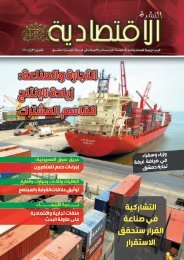SIGAR
2017-01-30qr
2017-01-30qr
Create successful ePaper yourself
Turn your PDF publications into a flip-book with our unique Google optimized e-Paper software.
ECONOMIC AND SOCIAL DEVELOPMENT<br />
City while turbine-installation work at Kajaki Dam was under way.<br />
USFOR-A has six other ongoing power projects, while USAID has three, as<br />
shown in Table 3.22 on page 172. 718<br />
AIF projects use FY 2011–FY 2014 appropriated funds. No additional<br />
AIF money was requested or appropriated, but up to $50 million from the<br />
FY 2016 Afghanistan Security Forces Fund may be used under limited circumstances<br />
to help finish existing projects. 719<br />
Transportation<br />
Afghanistan’s lack of transportation infrastructure hinders internal<br />
commerce, foreign trade, and economic growth. The World Bank said<br />
Afghanistan’s transportation-infrastructure shortcomings constrain the service<br />
and agriculture sectors, which have typically been the leading drivers<br />
of the economy. They also hold back the mining industry, future revenues<br />
from which the Afghan government and international donor community are<br />
hoping will offset declining international aid. 720<br />
This quarter, the Afghan government made additional progress in establishing<br />
regional connectivity. On October 30, 2016, Turkmenistan and<br />
Afghanistan inaugurated a rail line connecting the Atamyrat-Imamnazar railway<br />
in Turkmenistan to Aqina in Afghanistan. 721<br />
Roads<br />
Afghanistan has more than 76,400 miles of road, 28,000 of which have been<br />
rehabilitated or improved. 722 Last quarter <strong>SIGAR</strong> auditors assessed the conditions<br />
of approximately 1,020 miles of Afghanistan’s U.S.-funded national<br />
and regional highways, and found that most were in need of repair and<br />
maintenance. 723 The World Bank similarly reported that 85% of Afghanistan’s<br />
roads are in poor shape; the majority cannot be used year-round. 724<br />
Since 2002, USAID has provided more than $2 billion for more than 1,240<br />
miles of road construction, operations and maintenance (O&M), and capacity-building<br />
activities. 725 For its part, DOD provided at least $847 million on<br />
4,687 road-related projects under the Commander’s Emergency Response<br />
Program. Despite this investment, <strong>SIGAR</strong> auditors determined that USAID<br />
and DOD have had only limited success in ensuring the long-term sustainability<br />
of those roads. 726<br />
Afghanistan does not currently have sufficient funding and technical<br />
capacity to maintain its roads and highways, according to USAID.<br />
Afghanistan is estimated to spend $17 million annually for O&M, but that<br />
is $100 million less than the Asian Development Bank says is needed. 727<br />
USAID told <strong>SIGAR</strong> it would cost an estimated $8.3 billion to replace<br />
Afghanistan’s roads if they were not maintained. 728<br />
Money aside, a USAID assessment from May 2015 found that the Ministry<br />
of Public Works needed structural reform, citing ongoing critical weaknesses,<br />
including a lack of skilled staff, poor communication, antiquated<br />
The United Nations reported that the<br />
Taliban is increasingly using improvised<br />
explosive devices to disrupt economic and<br />
social activity in Afghanistan, not only<br />
beyond areas of direct conflict, but also on<br />
economically important roads.<br />
Source: UN, Report of the Analytical Support and Sanctions<br />
Monitoring Team, 10/5/2016, pp. 3, 7.<br />
REPORT TO THE UNITED STATES CONGRESS I JANUARY 30, 2017<br />
171







